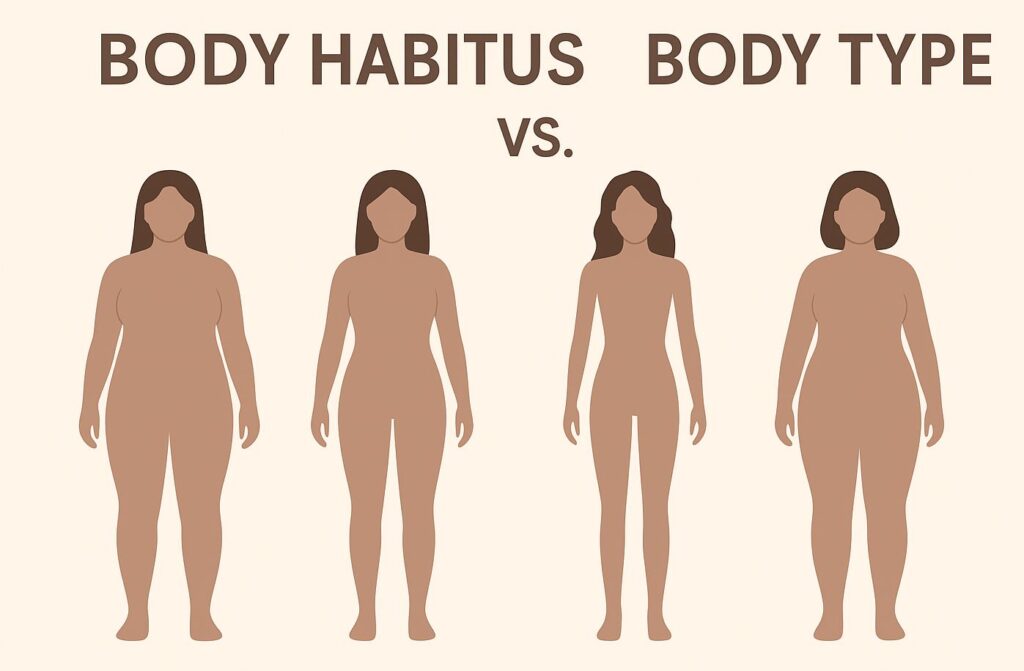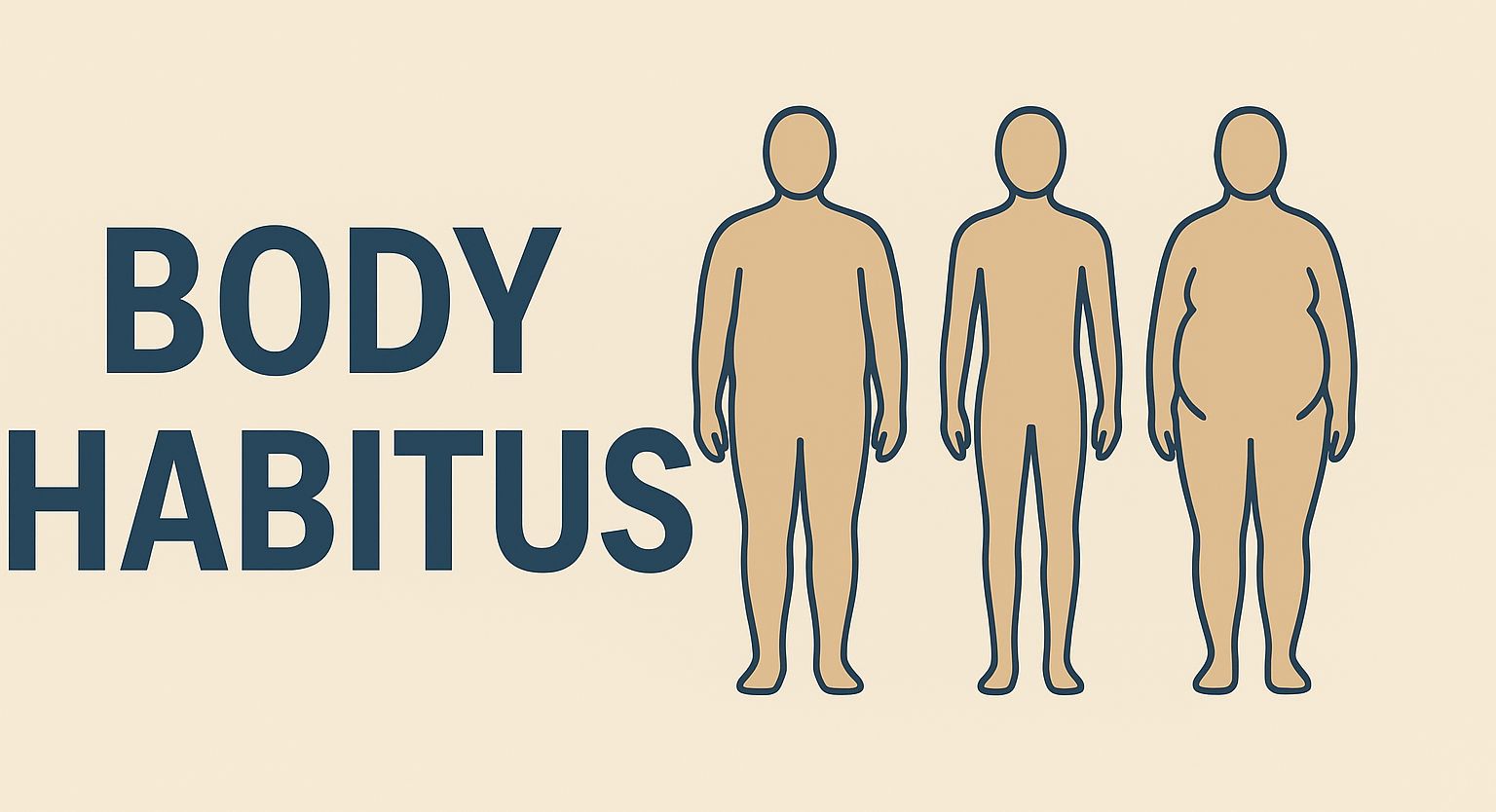Table of Contents
Introduction: The Hidden Blueprint of Your Body
Body habitus is a medical term that describes a person’s general physical build — including height, shape, weight, and frame. It’s the blueprint of your appearance and can tell a lot about your health. Doctors rely on this concept to interpret X-rays, assess risk factors, and plan treatments. But outside the medical field, many people are still unsure what this term really means.
Is it just about being thin or heavy? Or does it reveal something deeper about how the body functions? This article explores the meaning, types, and importance of body habitus in simple, practical terms — and clears up some common misconceptions.
1. What Is Body Habitus?
The term body habitus refers to the overall build or physique of an individual. It combines several physical features such as bone structure, muscle tone, and fat distribution.
In medicine, describing a person’s body structure is essential for accurate diagnoses. For example, a radiologist reviewing a chest X-ray must account for whether the patient is broad-shouldered, muscular, or very thin, since those differences can change how internal organs appear on an image.
Essentially, this term helps healthcare professionals understand how a person’s physical composition might influence what they see or treat.
2. What Does Body Habitus Mean in Simple Terms?
When medical notes mention “average habitus” or “slender habitus,” they’re referring to a person’s overall body shape. The meaning goes beyond simple weight categories — it’s about how someone’s body is naturally built.
Doctors and nurses use this description because it provides a quick snapshot of a patient’s frame, helping them adjust medical interpretations. For instance, a compact or heavyset person might show a different chest contour on an X-ray compared to someone lean or tall, even if both are healthy.
So, in simple terms, it means the natural shape and structure of your body — how it’s built, not just how much it weighs.
3. Does It Mean Being Fat? The Common Misunderstanding
A frequent question people ask is, “Does body habitus mean fat?” The answer is no. It doesn’t label someone as overweight or underweight — it’s a neutral term. It’s used for everyone, from lean athletes to broad, stocky individuals.
In medical evaluations, all body builds fall into one of several types, each carrying distinct characteristics. Let’s take a closer look at these classifications.
4. The Main Types of Body Habitus
Medical professionals often group people into five main categories based on structure, proportion, and weight distribution. Each type affects posture, organ placement, and even how certain diseases appear.
Hypersthenic (Broad and Solid Build)
This category includes individuals with a short, wide torso and strong frame. Their chest and abdomen are broad, and they usually have more muscle or fat mass.
- Features: Thick neck, wide shoulders, compact shape.
- Imaging insight: Organs may appear higher and more horizontal in scans.
- Health note: Higher body mass can contribute to heart strain or breathing difficulty in some cases.
Sthenic (Balanced and Athletic)
Considered the “average” build, this group shows proportional muscle and fat distribution.
- Features: Well-balanced torso, moderate muscle tone, even posture.
- Imaging insight: Organs typically appear in standard anatomical positions.
- Health note: Generally low risk, depending on lifestyle.
Hyposthenic (Slender and Graceful)
People with this physique have tall, narrow frames and light muscle mass.
- Features: Long limbs, small waist, narrow chest.
- Imaging insight: Organs may appear slightly lower in the body.
- Health note: May need to maintain higher calorie intake to support metabolism.
Asthenic (Extremely Thin Build)
This is the slimmest type, often characterized by low fat and muscle mass.
- Features: Flat chest, long abdomen, fragile bone structure.
- Imaging insight: Heart appears elongated and narrow.
- Health note: May be prone to fatigue or nutritional deficiencies.
Obese (High Fat Composition)
This type features greater body fat and rounder proportions.
- Features: Thick body wall, wide waist, rounded abdomen.
- Imaging insight: Organs can appear less distinct due to fat density.
- Health note: May face higher risks for heart disease, diabetes, and joint strain.
5. How Professionals Describe Body Structure
Describing someone’s physique in a medical or fitness setting follows a structured process. Professionals observe posture, proportion, and composition rather than using judgmental terms.
A typical clinical note might read:
“Patient presents with a hyposthenic build, tall and slender with narrow shoulders and low muscle mass.”
This kind of description helps doctors interpret imaging results or choose the right equipment sizes. It’s factual, not opinion-based.
Here’s how experts generally assess physique:
- Overall appearance: General impression of size and proportion.
- Frame structure: Shoulder width, rib cage shape, limb length.
- Muscle and fat distribution: Even or uneven tone.
- Posture and stance: Indicates balance and bone alignment.
- Classification: One of the five body habitus categories listed above.
6. Why Body Habitus Matters in Medicine
This concept might sound purely descriptive, but it plays a vital role in healthcare. Here’s why:
a. Better Diagnostic Accuracy
When reading X-rays or CT scans, radiologists must know a patient’s build. A compact frame might make organs look closer together, while a lean frame reveals more detail. Without this context, a scan could be misread.
b. Correct Medication Dosing
Drug absorption differs between individuals. Someone with more body fat processes fat-soluble medications differently than a thin person. Knowing a patient’s physique helps doctors prescribe accurate doses.
c. Safer Surgical Planning
Surgeons consider physical structure before making incisions or choosing instruments. For example, an abdominal surgery on a broad, muscular patient requires different access points than on a slender one.
d. Predicting Disease Risk
Certain body builds correlate with specific health challenges.
- Stocky builds may face higher cardiovascular strain.
- Very thin individuals might lack muscle reserves.
- Obesity increases metabolic and joint stress.
e. Tailoring Fitness and Nutrition Plans
In sports and fitness, identifying one’s physique helps design personalized exercise and diet programs that match metabolic needs.
7. The Role of Genetics and Lifestyle
Your physique isn’t just shaped by diet — it’s also influenced by genetics, culture, and daily habits. Bone density, fat storage patterns, and muscle growth tendencies are often inherited.
Environmental factors also matter. People in physically active environments tend to develop more muscle tone, while sedentary lifestyles can reduce lean mass. Nutrition, stress, and even sleep patterns influence how the body develops over time.
In short, your build is the result of both nature and nurture — an interplay between what you inherit and how you live.
Body Habitus vs. Body Type: Subtle but Important Differences

Many people confuse “body habitus” with “body type.” The difference lies in context:
- Body habitus is a medical term, used in radiology and clinical documentation.
- Body type is a general or fitness-related concept, often referring to somatotypes (ectomorph, mesomorph, endomorph).
While both describe shape, body habitus focuses on medical and anatomical traits, not aesthetics.
How to Identify Your Own Build
You don’t need specialized equipment to understand your general body structure. Here’s how to assess it:
- Look at your frame: Are you broad-shouldered, balanced, or narrow?
- Check proportions: How do your torso and limbs compare in length?
- Observe fat distribution: Evenly spread or centered in one area?
- Consider height-to-weight ratio: Tall and lean or compact and solid?
- Notice muscle tone: Firm and visible or soft and rounded?
A doctor or trainer can give a more precise classification, but simple self-observation often gives good insight into which category fits best.
Conclusion: Your Structure Tells a Story
Your body habitus is far more than how you look in the mirror — it’s a biological signature that influences your health, fitness, and how doctors interpret your medical results. Understanding your physical structure allows you to take a more informed approach to wellness.
Whether your frame is broad, balanced, or slender, remember that every build carries its own strengths and challenges. Learning about your body’s natural design helps you make smarter lifestyle choices and appreciate the diversity of the human form
FAQs
1. What is body habitus?
It’s the medical term for a person’s general physical build, including height, weight, bone structure, and muscle or fat distribution.
2. What does body habitus mean?
It refers to the body’s natural shape and proportions, often used by healthcare providers to interpret exams or plan treatments.
3. Does body habitus mean fat?
No. It’s a neutral description for all builds — thin, muscular, or large. It doesn’t imply obesity or any negative connotation.
4. What is body habitus mean?
It means the overall physical constitution or physique of an individual, often used in clinical documentation.
5. How to describe body habitus?
Professionals describe it based on frame size, fat distribution, muscle tone, and overall proportion — using terms like hypersthenic, sthenic, hyposthenic, asthenic, or obese.



